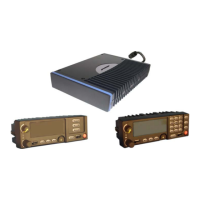MM-015371-001, Rev. C
46
10 CABLE CONNECTIONS
10.1 DC POWER CONNECTIONS
10.1.1 Overview of On/Off Power Wiring Configurations
Radio on/off power control is accomplished by the control head. In a standard installation, when the
control head is turned on, it “wakes-up” the radio via data activity on the CAN link. The following power
wiring configurations are supported:
Radio turns on and off automatically with vehicle’s ignition switch/key — This configuration
allows the on/off state of the vehicle’s ignition switch/key to control the on/off power state of the
radio. The white wire of the control head’s
DC Power Cable is connected to a fused switched power
source, typically identified as vehicle “Accessory” power. This source must switch on (up to positive
(+) battery voltage potential) when the vehicle’s ignition switch/key turns on, and it must switch off
(to near zero volts) when the ignition switch/key turns off. The required fuse rating is 3 amperes.
When using this configuration, the CH-721 control head’s on/off/volume control must be left in the
on position for automatic power-up/down to function properly.
A waterproof (HFB type) fuse holder and a 3-amp AGC fuse are included with the
control head’s DC Power Cable to fuse this cable’s white wire.
Radio turns on and off with a manual switch — This configuration is used when, for example, the
radio must remain on even when the ignition key must be removed from the vehicle and
a separate
on/off switch is acceptable. The white wire of the control head’s
DC Power Cable is connected to one
side of a manually-controlled switch, and the other side of this switch is connected to unswitched and
fused vehicle power. The required fuse rating is 3 amperes. When using this configuration, the
CH-721 control head’s on/off/volume control must be left in the on position
for automatic power-
up/down to function properly.
Radio turns on with control head’s on/off/volume control (“hot wired”) — This configuration
allows radio on/off power control only via the control head’s
on/off/volume control. It may be desired
if, for example, the radio must remain on even when the ignition key must be removed from the
vehicle and a separate on/off switch is not desired and/or not acceptable. The white wire of the
control head’s
DC Power Cable must be connected to unswitched and fused vehicle power. The
required fuse rating is 3 amperes.
In all of the above cases, both the radio’s main DC power input (red wire) and the control head’s main
DC power input (also a red wire) must be connected to unswitched
vehicle DC power (12-volts nominal)
via an Alternator Whine Reject Filter located in the motorcycle radio case. DC power supplied to this
filter is over-current protected by a fuse installed near the DC power source (i.e., near the motorcycle’s
positive battery terminal). The white ignition wire of the radio’s
DC Power Cable is not used/not
connected in motorcycle applications.
10.1.2 Alternator Whine Reject Filter Installation
Install the Alternator Whine Reject Filter in the weatherproof radio case as follows:
1. Obtain Alternator Whine Reject Filter 19A703965P2 from the installation kit.
2. Using a T10 Torx screwdriver, mount the filter to the inside bottom floor of the radio case using the
four (4) stainless-steel M3 x 8-millimeter-long screws and M3 washers supplied in Hardware Kit

